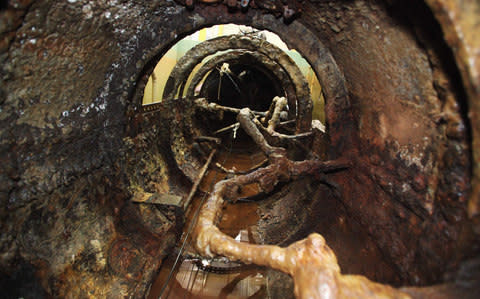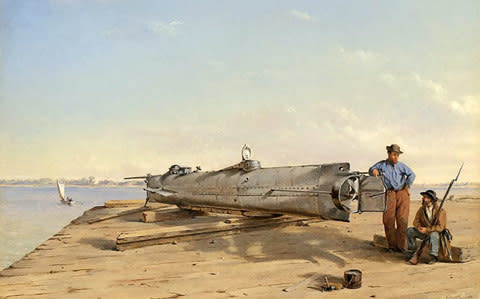Mystery deaths of HL Hunley submarine crew solved - they accidentally killed themselves

The mystery of how the crew of one of the world’s first submarines died has finally been solved - they accidentally killed themselves.
The HL Hunley sank on February 17 1864 after torpedoing the USS Housatonic outside Charleston Harbour, South Carolina, during American Civil War.
She was one of the first submarines ever to be used in conflict, and the first to sink a battleship.
It was assumed the blast had ruptured the sub, drowning its occupants, but when the Hunley was raised in 2000, salvage experts were amazed to find the eight-man crew poised as if they had been caught completely unawares by the tragedy. All were still sitting in their posts and there was no evidence that they had attempted to flee the foundering vessel.

Now researchers at Duke University believe they have the answer. Three years of experiments on a mini-test sub have shown that the torpedo blast would have created a shockwave great enough to instantly rupture the blood vessels in the lungs and brains of the submariners.
"This is the characteristic trauma of blast victims, they call it 'blast lung,'" Dr Rachel Lance.
“You have an instant fatality that leaves no marks on the skeletal remains. Unfortunately, the soft tissues that would show us what happened have decomposed in the past hundred years.”
The Hunley's torpedo was not a self-propelled bomb, but a copper keg of 135 pounds of gunpowder held ahead and slightly below the Hunley's bow on a 16-foot pole called a spar
The sub rammed this spar into the enemy ship's hull and the bomb exploded. The furthest any of the crew was from the blast was about 42 feet. The shockwave of the blast travelled about 1500 meters per second in water, and 340 m/sec in air, the researchers calculate.

While a normal blast shockwave travelling in air should last less than 10 milliseconds, Lance calculated that the Hunley crew's lungs were subjected to 60 milliseconds or more of trauma.
"That creates kind of a worst case scenario for the lungs," added Dr Lance. “Shear forces would tear apart the delicate structures where the blood supply meets the air supply, filling the lungs with blood and killing the crew instantly.
“It's likely they also suffered traumatic brain injuries from being so close to such a large blast.
"All the physical evidence points to the crew taking absolutely no action in response to a flood or loss of air. If anyone had survived, they may have tried to release the keel ballast weights, set the bilge pumps to pump water, or tried to get out the hatches, but none of these actions were taken.”

The fate of the crew of the 40-foot Hunley remained a mystery until 1995, when the submarine was discovered about 300 meters away from the Housatonic's resting place.
Raised in 2000, the submarine is currently undergoing study and conservation in Charleston by a team of Clemson University scientists.
Initially, the discovery of the submarine only seemed to deepen the mystery. The crewmen's skeletons were found still at their stations along a hand-crank that drove the cigar-shaped craft.
They suffered no broken bones, the bilge pumps had not been used and the air hatches were closed. Except for a hole in one conning tower and a small window that may have been broken, the sub was remarkably intact. Speculation about their deaths has included suffocation and drowning.
The new study involved repeatedly setting blasts near a scale model, shooting authentic weapons at historically accurate iron plate and calculating human respiration and the transmission of blast energy.
The research was published in PLOS ONE.
Related:
For more news videos visit Yahoo View, available on iOS and Android.

